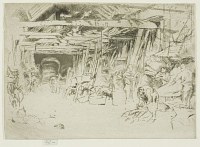Wheelwright | ||
| Number: | 240 | |
| Date: | 1880 | |
| Medium: | etching and drypoint | |
| Size: | 127 x 177 mm | |
| Signed: | butterfly at lower left, faint butterfly upper left | |
| Inscribed: | no | |
| Set/Publication: | 'Second Venice Set', 1886 | |
| No. of States: | 9 | |
| Known impressions: | 29 | |
| Catalogues: | K.233; M.230; W.162 | |
| Impressions taken from this plate (29) | ||
TECHNIQUE
Most of the composition was executed in etching, with drypoint shading added and removed during the course of nine states. Whistler rebit the etched shading on and around the covered wagon in the background when those lines became worn and indistinct. In the process, acid apparently came in contact with other areas of the plate; the beams and supports on the right are covered with fine, granular foul biting in the eighth and ninth states, and foul biting in the shape of acid droplets appears at the upper right corner.
PRINTING
The first state was printed in black ink on ivory 'antique' (pre-1800) laid paper (). Subsequent proofs - individual impressions of the next four states - are in black ink. Judging from Whistler's graphite butterfly signature, the second and third states were printed around 1881 (, ), the fourth and fifth states about 1883/1884 (), and the sixth in 1885 or 1886 (, ). Later states were all printed in 1886. Most of these states were printed in small numbers. Nearly all were trimmed to the platemark and signed on a tab with the butterfly and 'imp.' to show that Whistler had printed them (occasionally the tab was cut off by mistake and Whistler signed the etching on the verso instead (i.e. ).
Comparatively few impressions of Wheelwright were printed on watermarked laid papers, although one impression of the sixth state was printed in black ink on paper with the watermark 'B / TH' in a decorative circle () and another in dark brown ink on ivory laid paper with a partial 'PRO PATRIA' watermark ().
In 1886 Whistler was satisfied with the seventh state and submitted the copper plate to the publishers, Messrs Dowdeswell and Thibaudeau, who gave it to Émile Frédéric Salmon (1840-1913) to be printed. He printed an impression in black ink on fine light-weight pale buff paper (). Salmon produced a fine clear, sharp impression, but his approach was not apparently what Whistler wanted and the artist took over the task of printing the edition himself. Other impressions of the seventh state were printed by Whistler both in dark brown ink on buff laid paper, possibly Asian () and black ink on ivory Asian laid paper ().
There are numerous dockets, receipts and lists recording the printing and delivery of Wheelwright for the 'Second Venice Set' in 1886. One impression was delivered on 20 August and three on 2 October 1886, and finally a large consignment - twenty-nine - on 15 January 1887, making a total of 33. 5
5: Whistler to W. Dowdeswell, [16 July 1887], GUW #08717.
The eighth state - again, only a few were printed - was printed in very dark brown ink on light-weight cream laid paper () and in black ink on pinkish-ivory Asian laid paper darkened to tan ().
The remaining impressions - presumably of the ninth and final state, delivered on 15 January 1887 - were printed in various shades of ink and paper. Many were in black ink, on papers including ivory western laid () and laid paper discoloured to buff (, ), and on Asian laid paper, likewise discoloured to buff (, ). Others were in dark brown ink on cream laid paper darkened to buff (). It appears that Whistler liked the darkened paper for this etching and augmented the effect with carefully wiped surface tone ().
